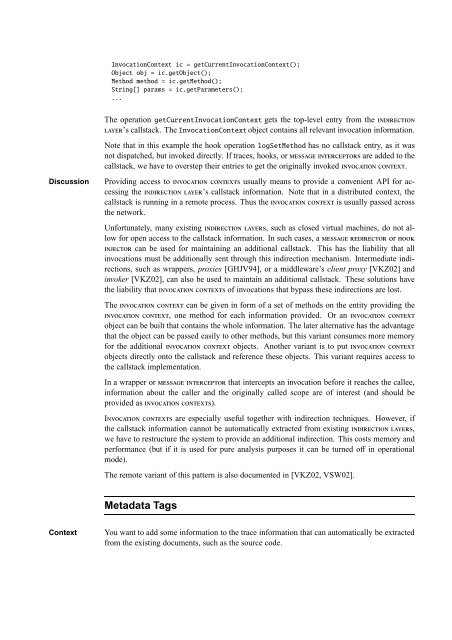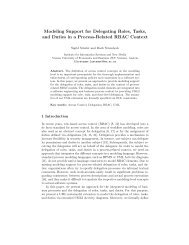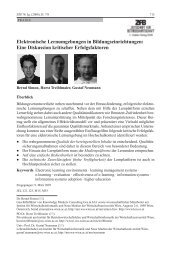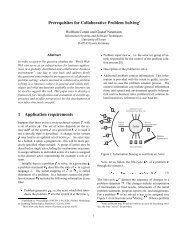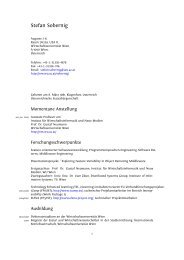Patterns of Tracing Software Structures and Dependencies
Patterns of Tracing Software Structures and Dependencies
Patterns of Tracing Software Structures and Dependencies
You also want an ePaper? Increase the reach of your titles
YUMPU automatically turns print PDFs into web optimized ePapers that Google loves.
InvocationContext ic = getCurrentInvocationContext();Object obj = ic.getObject();Method method = ic.getMethod();String[] params = ic.getParameters();...The operation getCurrentInvocationContext gets the top-level entry from the INDIRECTIONLAYER’S callstack. The InvocationContext object contains all relevant invocation information.Note that in this example the hook operation logSetMethod has no callstack entry, as it wasnot dispatched, but invoked directly. If traces, hooks, or MESSAGE INTERCEPTORS are added to thecallstack, we have to overstep their entries to get the originally invoked INVOCATION CONTEXT.DiscussionProviding access to INVOCATION CONTEXTS usually means to provide a convenient API for accessingthe INDIRECTION LAYER’S callstack information. Note that in a distributed context, thecallstack is running in a remote process. Thus the INVOCATION CONTEXT is usually passed acrossthe network.Unfortunately, many existing INDIRECTION LAYERS, such as closed virtual machines, do not allowfor open access to the callstack information. In such cases, a MESSAGE REDIRECTOR or HOOKINJECTOR can be used for maintaining an additional callstack. This has the liability that allinvocations must be additionally sent through this indirection mechanism. Intermediate indirections,such as wrappers, proxies [GHJV94], or a middleware’s client proxy [VKZ02] <strong>and</strong>invoker [VKZ02], can also be used to maintain an additional callstack. These solutions havethe liability that INVOCATION CONTEXTS <strong>of</strong> invocations that bypass these indirections are lost.The INVOCATION CONTEXT can be given in form <strong>of</strong> a set <strong>of</strong> methods on the entity providing theINVOCATION CONTEXT, one method for each information provided. Or an INVOCATION CONTEXTobject can be built that contains the whole information. The later alternative has the advantagethat the object can be passed easily to other methods, but this variant consumes more memoryfor the additional INVOCATION CONTEXT objects. Another variant is to put INVOCATION CONTEXTobjects directly onto the callstack <strong>and</strong> reference these objects. This variant requires access tothe callstack implementation.In a wrapper or MESSAGE INTERCEPTOR that intercepts an invocation before it reaches the callee,information about the caller <strong>and</strong> the originally called scope are <strong>of</strong> interest (<strong>and</strong> should beprovided as INVOCATION CONTEXTS).INVOCATION CONTEXTS are especially useful together with indirection techniques. However, ifthe callstack information cannot be automatically extracted from existing INDIRECTION LAYERS,we have to restructure the system to provide an additional indirection. This costs memory <strong>and</strong>performance (but if it is used for pure analysis purposes it can be turned <strong>of</strong>f in operationalmode).The remote variant <strong>of</strong> this pattern is also documented in [VKZ02, VSW02].Metadata TagsContextYou want to add some information to the trace information that can automatically be extractedfrom the existing documents, such as the source code.


